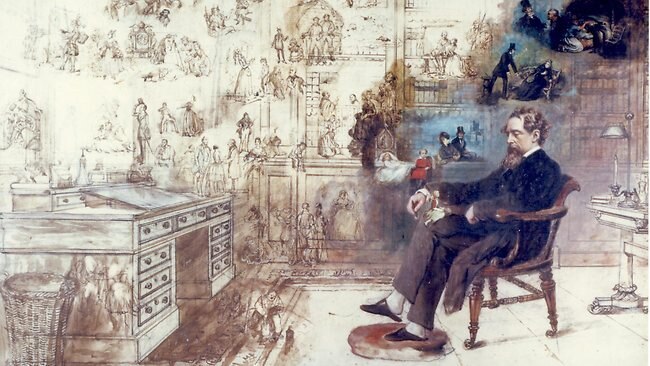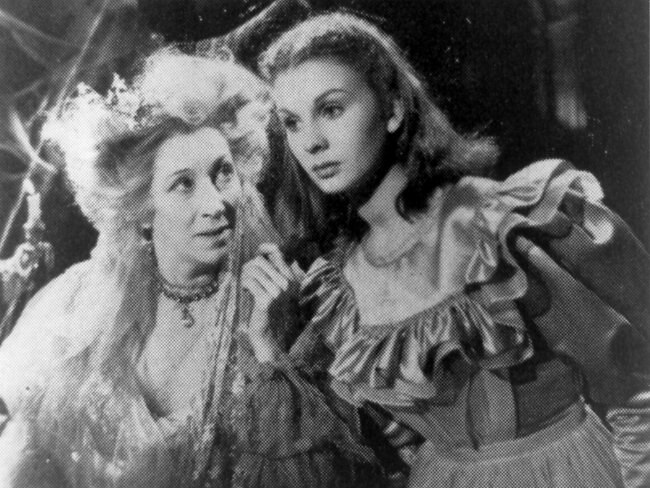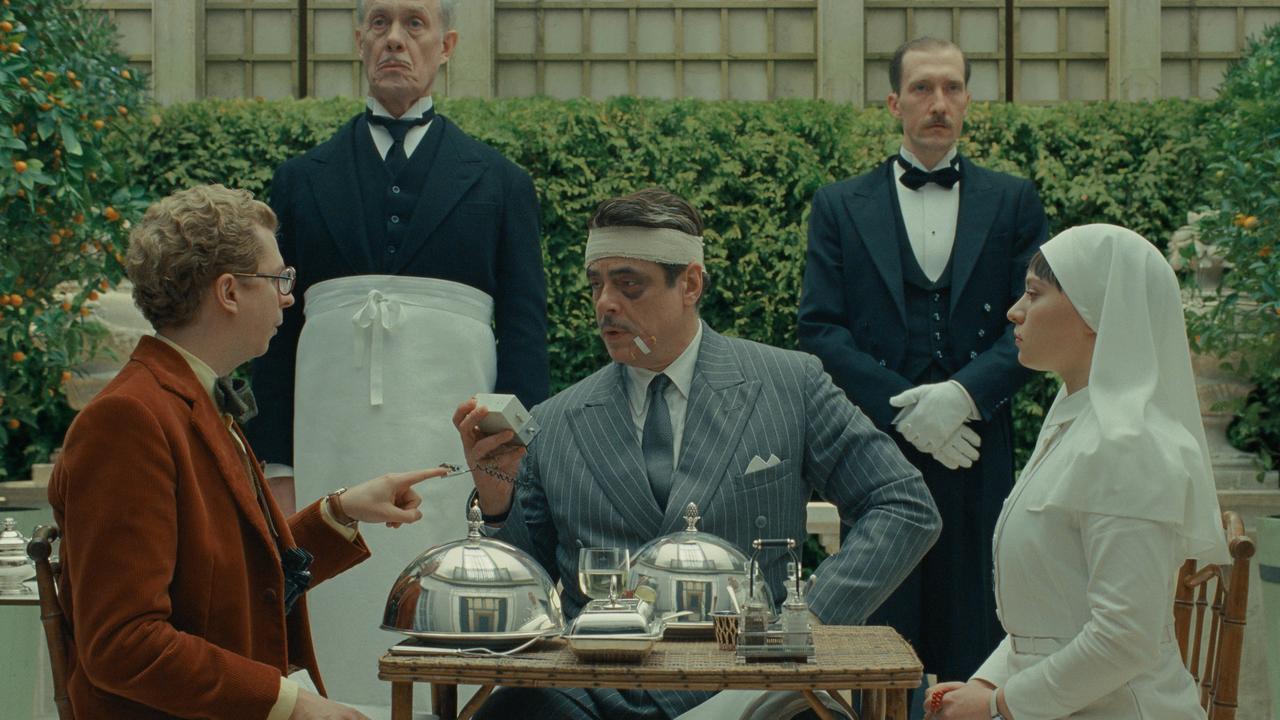The world according to Charles Dickens
THE most famous 19th century English novelist continues to exert his spell, on stage, in books and on screen.
CHARLES Dickens was born on February 7, 1812, at Portsmouth, England, the second of John and Elizabeth Dickens's eight children.
In 1815 they moved to London; when Dickens was 12 his father was sent to Marshalsea debtors' prison and Charles was forced to work in a blacking factory to support the family. He was later an office boy at a solicitors' firm and a freelance reporter. His first short story was published in 1833 and his first book, a collection of stories titled Sketches by Boz, was published in 1836, the year Pickwick Papers started to appear in instalments. He died on June 9, 1870, and is buried in Westminster Abbey.
According to Dickens expert Jennifer Gribble, from the University of Sydney's English department, " 'Dickensian' has come to signify the poverty, squalor and injustice of industrial civilisation. Dickens's defence of the neglected and socially marginalised has lost none of its relevance. Countless adaptations of his novels for stage and screen show the appeal of his suspenseful plots and vividly created scenes. He was a great dramatist who happened to write in prose. His genius for dialogue, comedy and pathos, and his psychological insight, has given us some of the most memorable characters in our literature. Not the least of these are representations of his own complex and increasingly troubled self - David Copperfield, Pip, and the unfinished John Jasper [The Mystery of Edwin Drood]."
With this in mind, Review asked our experts to select their best of Charles Dickens (pictured below):
TOP FIVE NOVELS
Great Expectations: It is fair to say that every novel by Dickens is flawed in some small way or large: except this one, his masterpiece. G.K. Chesterton wrote that it has a quality of serene irony and even sadness, which puts it quite alone among his other works. No one who has read the novel will have forgotten its final lines: "I took her hand in mine, and we went out of the ruined place; and, as the morning mists had risen long ago when I first left the forge, so, the evening mists were rising now, and in all the broad expanse of tranquil light they showed to me, I saw no shadow of another parting from her."
Bleak House: The best opening paragraphs of any English novel. The most sustained and fantastic critique of the law mounted this side of Kafka's Trial. A rousing broadside aimed at telescopic philanthropy, that is, those who would do good deeds abroad while letting their neighbours starve at home. Oh, and with Inspector Bucket, Dickens has invented the modern novel of detection.
Our Mutual Friend: Dickens's last complete work was the author's most sophisticated - and his most damning - indictment of its era. In a novel that should grace the library of every Occupy encampment, Dickens takes a cudgel to the Victorian one-percenters. Edgar Johnson, Dickens's best American biographer, wrote of the novel's vision of London as an enormous dust-heap that its filth symbolises acquisition as the supreme value of a monetary barbarism that had made its world into a wasteland.
David Copperfield: The influence of Dickens's most autobiographical novel has been so immense over such a long period that it has become a cliche. Which is a shame, since it is also one of his grandest imaginative efforts. It was the favourite Dickens of Chesterton and Sigmund Freud, Joyce wrote it into the fabric of Ulysses, and Dostoevsky read it in Russian while serving time in a Siberian prison camp.
Nicholas Nickleby: Dickens's third novel is his first mature work: the hinge on which his career as a novelist turns. Poor, young, honourable Nicholas Nickleby is Dickens's ur-hero, a young gentleman forced by poverty out into the sordid world. The evil schoolmaster Wackford Squeers; the sweetly obtuse Mrs Nickleby; and the magnificently tedious Mr Vincent Crummles are early versions of the author's great grotesques. The real Dickens starts here.
Geordie Williamson, chief literary critic for The Australian
TOP FIVE BIOGRAPHIES
G.K. Chesterton, Appreciations and Criticisms: Simply the best book on Dickens. Chesterton was one of the few writers of his generation with demonic energy to equal that of Dickens. His slender book is packed with more insights than a hundred scholarly monographs. Dickens's reputation was wrenched - almost single-handedly - from its post-Victorian slide and the book set the author on the path to literary immortality. Dickens was no Puritan, argued Chesterton, but a survivor from the Merry England of Chaucer and the Elizabethans.
Fred Kaplan, Dickens: A Biography: The most tidy, complete, and well-rounded Life. Kaplan's book lacks much in the way of fresh news, but its meticulous scholarship and deep knowledge of the Victorian period makes it the most reliable modern biography (it was published in 1989; those who have read it suggest Michael Slater's cautious and judicious Charles Dickens from 2009 does a similar job).
John Forster, The Life of Charles Dickens: Not only was Forster Dickens's closest friend and confidant over many years, he also served as the author's editor and literary agent. His Life, which appeared in three volumes soon after Dickens's death, is the wellspring to which all subsequent biographers return. If the work suffers from being overly respectful to its subject, Forster's love and admiration are sincerely and honourably expressed.
Claire Tomalin, The Invisible Woman: This tells the story of Charles Dickens and Ellen Ternan, the young actress with whom he had a secret 12-year relationship after fleeing his long and unhappy marriage. The news about Ellen had been broken long before this book's publication in 1991, in Edgar Johnson's magisterial mid-century biography Charles Dickens: His Tragedy and Triumph (1952; 1977) but by placing the actress at the centre of the book Tomalin (pictured above) radically alters our perspective. A much-needed feminist reconfiguration of the Dickens myth.
Peter Ackroyd, Dickens: A Biography: Ackroyd's 1990 book is notorious for interpolated scenes in which Dickens holds fictional conversations with the biographer and Oscar Wilde, among others. Overwritten and generally hectic, Ackroyd's biography is nonetheless the only modern Life that captures something of the volcanic spirit of its great subject. If the fictional chats put you off, don't worry: they have been removed from later editions.
Geordie Williamson
BEST STAGE ADAPTATIONS
I AM with E.M. Forster: those who dislike Dickens have an excellent case. I have not finished a single Dickens novel by choice. Ever. They have all been "hate reads" (duress reads at the very least) for work or study. Yet the very elements that make Dickens a (penny)-dreadful novelist - the mawkishness, the sensationalism, the sentimentality - make for good, even irresistible, melodrama. Which is why Lionel Bart's Oliver! is a near-perfect musical. It turns gruel into . . . glorious gruel. All it took was an exclamation mark and a revolving set. The West End show launched the crooning career of an apprentice jockey named Davy Jones and took him to Broadway. Imagine: without Dickens, we might not have the Monkees.
Dickens wrote two kinds of women: the innocent and the grotesque; bland young angels (17, indistinguishable and utterly, utterly nice) and creepy, painted, psychotic, blowzy harridans. Miriam Margolyes, surprise surprise, opted to play the latter mob. She gave us a freak show and acting master class in her earthy, clever and wonderfully polished one-hander Dickens' Women in the latter half of the past decade and is about to do so again.
The celebrated flatness, the zero-dimensionality, of Dickens's men is seen as an opportunity and a great challenge by thespians. It takes all the magic of a great cast to inflate Dickens's universe. David Edgar's eight-hour adaptation of Nicholas Nickleby for the Royal Shakespeare Company (which toured the world in the 1980s) was one of the greatest theatrical conjuring jobs of contemporary English theatre. One of the greatest con jobs of Australian theatre was a feisty and touching stage adaptation of A Christmas Carol by Janis Balodis and Peter Matheson. The 1990 production, for Melbourne Theatre Company, featured Frank Gallacher as a splendid Scrooge, in a story re-set in outback Australia in the 19th century. The rituals of the old country were faithfully re-enacted in a different climate and different season. Instead of a blizzard, the play began with a howling dust-storm. It worked brilliantly.
An honourable mention goes to Simon Callow (pictured above) who starred in The Mystery of Charles Dickens, Peter Ackroyd's warts-and-all biography, which I saw at Sydney's Theatre Royal in 2002. Callow animated Dickens's pantheon of rogues with awesome ease and alchemical skill. His timing was flexible, intuitive, sure.
Chris Boyd, Melbourne theatre critic for The Australian
BEST TELEVISION ADAPTATIONS
Little Dorrit (2008): Adapted by Andrew Davies for the BBC, this version of Dickens's sprawling tale of love, murder and redemption featured Claire Foy (pictured above, right), Tom Courtenay and Matthew Macfadyen, and was lauded by critics. Davies is master of the tricky magic of reducing a sprawling Victorian epic to a gripping, fast-moving fable for our times.
Bleak House (2005): This 15-part BBC serial (Davies again) has been described by critics as possibly the best adaptation of a Dickens novel to grace the small screen. Gillian Anderson as the aristocrat Lady Dedlock and Charles Dance as Mr Tulkinghorn spearheaded a huge ensemble cast, and the lavishly dark, dramatic depiction of a grimy London filled with "virulent cripples", in the words of one critic, earned it a swag of awards. In Davies's hands, this story of people imprisoned by means and circumstance and of legal bureaucracy gone woefully askew became a high-powered thriller.
A Christmas Carol (1984): The made-for-television special starring George C. Scott as Ebenezer Scrooge is a thoughtful and grounded adaptation characterised by Scott's impressive performance. I can still remember his delivery of the line: "God forgive me for the time I've wasted." Dickens would have loved the sense of just how hard it is for anyone to ever find redemption.
Graeme Blundell, national television critic for The Australian
BEST FILM ADAPTATIONS
David Copperfield (1935): This is remembered for W.C. Fields's immortal Mr Micawber and was directed with impeccable taste by George Cukor. It may be the finest of all Dickens films, faithfully capturing the melancholy beauty of Dickens's vision of the world, with all its hardship and good humour.
A Tale of Two Cities (1935): Of at least seven versions, MGM's lavish production, with Ronald Colman as the world-weary lawyer who gives his life for love in revolutionary France, still ranks as the best.
Great Expectations (1946): Brimful of unforgettable characters and scenes, and with memorable performances from John Mills, Martita Hunt, Francis L. Sullivan and Alec Guinness (in his first screen role), this magnificent film may be director David Lean's finest achievement.
Oliver! (1968): Lionel Bart's musical of Oliver Twist hadn't a dud number, and was filmed with wonderful zest by Carol Reed with some spectacular dance routines and charismatic performances by Ron Moody (pictured, left) as Fagin, Oliver Reed and a young Mark Lester.
Little Dorrit (1988): Directed by Christine Edzard, and starring Sarah Pickering as its seamstress heroine, this is the most ambitious of all adaptations of a Dickens novel -- six hours long and shown in two parts, with 211 speaking roles and never a dull moment.
Evan Williams, film critic for The Australian
Compiled by Sharon Verghis
What's your favourite Dickens adaptation and why? We'll publish your contributions on Monday morning.





